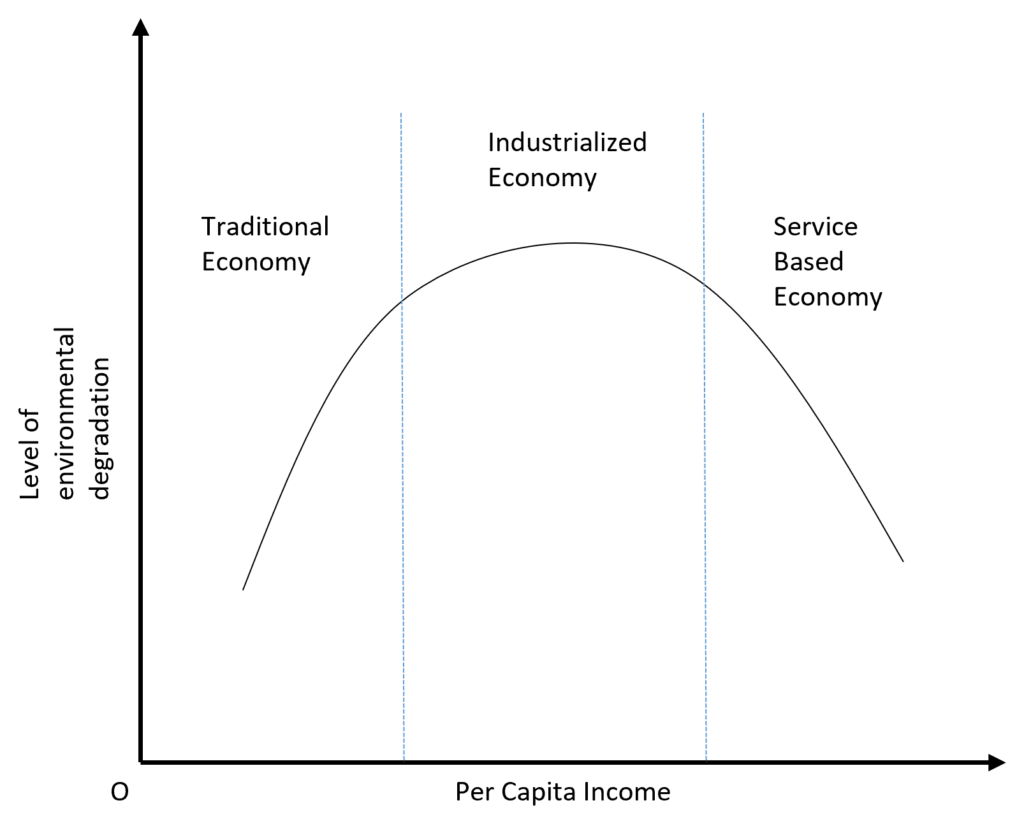Simon Kuznets observed a relationship between inequality and development which came to be known as the Kuznets Inverted-U hypothesis. He postulated that inequality in income distribution will rise during the early stages of development. With further development, inequality will increase to a maximum and eventually start decreasing in the later stages of growth and development.
As observed by Kuznets in some cases, when measures of income inequality such as the Gini coefficient are expressed as a function of per capita income, an inverted U-shaped curve can be observed. Hence, it is generally referred to as Kuznets’ Inverted-U curve.

Gini-Coefficient and Per-capita Income
Corrado Gini proposed the Gini coefficient in an attempt to measure income inequality. The Gini coefficient ranges from 0 to 1. A value of 0 on the Gini coefficient implies perfect equality, whereas, a value of 1 means perfect inequality. Hence, the higher the value of the Gini coefficient, the higher the level of income inequality. To learn more about the calculation of the Gini coefficient, see here.
As seen in the diagram, the value of the Gini coefficient increases in the early stages of development. This means that income inequality rises initially. However, with further growth and development of the economy, the Gini coefficient reaches a maximum and starts declining. This implies that income inequality eventually falls in the later stages of development.
Econometrics Tutorials with Certificates
Causes of inverted-U shape
- Structural changes: In the earlier stages, development is most likely to be concentrated in the industrial sector as the economy moves from a traditional to a modern industrial economy. The industrial sector is generally characterised by higher productivity and wages, but lower employment opportunities. This leads to a further increase in income inequality in the earlier stages and the Gini coefficient increases. To learn more about structural changes and related theories, go here.
- Migration: there will be an increase in demand for labour in the modern industrial sector with continuous development. Rural labour will start migrating to urban industrial centres, which are generally characterized by higher wages and inequality. As the modern sector grows with development, an inverted U-shape will emerge as the economy moves from the traditional to the modern economy. Because political institutions such as labour unions are created, it will increase the incomes of lower-wage workers. Therefore, this will contribute to bridging the income gap and help in reducing the inequalities as the economy develops.
- Returns to education: initially, returns to education will see a huge rise as demand for skilled labour rises with development. Skilled labour is associated with higher wages leading to increasing inequality. Hence, the Gini coefficient will increase in the beginning. However, the supply of educated labour will keep growing and the proportion of unskilled labour will fall with further development. Hence, inequalities in income will start falling with a rise in the proportion of the skilled labour force leading to an inverted U-shape.
Criticism
- Firstly, the empirical evidence in support of the Inverted-U hypothesis is mixed. It has been observed that income inequalities rise in developed countries such as the USA and Japan. Hence, the Kuznets Inverted-U fails to explain this phenomenon.
- Kuznets himself advocated that his hypothesis was based on insufficient data. It was based on very short time period data.
- The role of political and social reforms has been completely ignored in the hypothesis. Development and per capita income are not the only determinants of inequality. Policies by the government or the introduction of other reforms can have a huge impact on inequality irrespective of the per capita income.
adaptation to the Environmental Kuznets curve
The Kuznets curve has been adapted to explain changes in environmental degradation with development and growth. It deals with environmental degradation instead of income inequality in a similar manner to the original hypothesis.
The Environmental Kuznets curve states that pollution or environmental degradation increases in the earlier stages of development, reaches a maximum and starts decreasing with further growth and development.

The level of environmental degradation increases when the economy develops in the earlier stages. This happens because the economy shifts from traditional agriculture to an industrial economy. Industries are characterised by higher pollution levels and environmental degradation.
However, environmental degradation will eventually start declining with development. As the becomes highly industrialized and then shifts to a service-based economy, it will lead to the development of more efficient and green technology. With environment-friendly technology being developed, the level of pollution and degradation will go down.
Criticism
- Pollution is not just a function of income, it depends on several other factors. The relationship between development and environmental degradation is not so straightforward and simplistic.
- Growth generally brings even higher pollution through higher resource use. The eventual fall in pollution as proposed by this hypothesis may not arrive.
- Developed countries have been observed to have the highest CO2 emissions which contradict the hypothesis.
- It requires political or government intervention to reduce environmental degradation. It does not happen on its own. Given the option to continue as they are, the industries will not care about the environment or pollution.
- The hypothesis does not consider the irreversibility of environmental damage.
augmented Kuznets’ curve
One of the major criticisms of the Kuznets’ curve was the empirical evidence of rising inequality levels in developed countries. The majority of the developing countries were found to be on the downward trend of the Kuznets curve. However, inequality was observed to be increasing in high-income economies such as the USA.

It was postulated that the original Kuznets curve holds until the economies are producing consumer goods. Whereas, with a shift toward the production of capital goods in highly developed countries, inequality starts to rise again. These capital goods can be categorised as advanced technology goods that are monopolistic in nature and are produced by advanced industrial economies. These economies are found on the upward-sloping part of the Augmented Kuznets curve.
Econometrics Tutorials with Certificates
This website contains affiliate links. When you make a purchase through these links, we may earn a commission at no additional cost to you.


